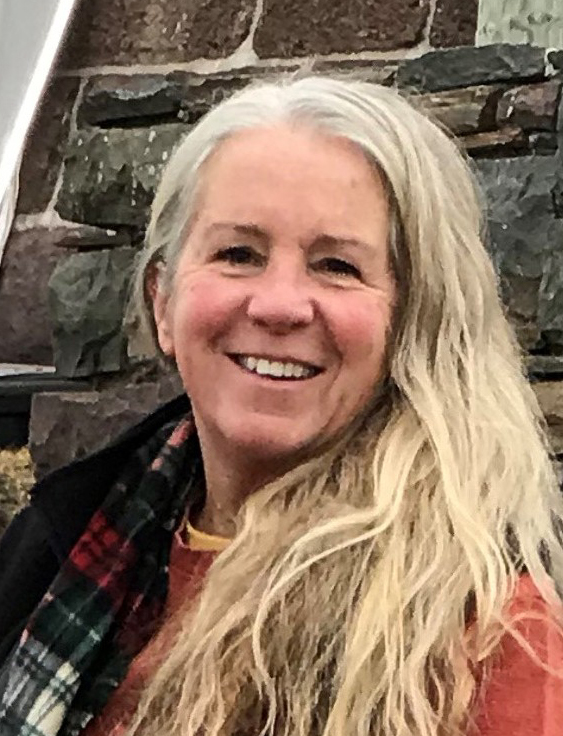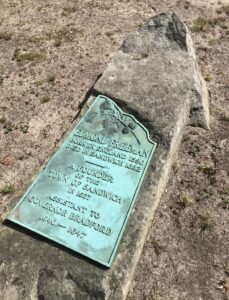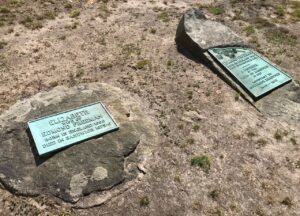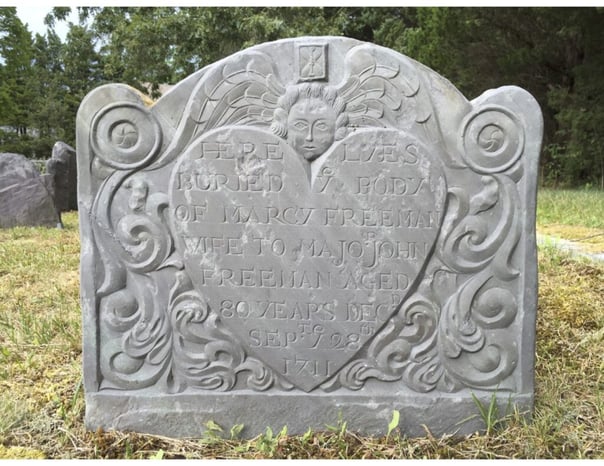Back in 2015, I was delighted to learn that my Elder William Brewster lineage for membership in the Massachusetts Mayflower Society had been approved. I had traced my descent through Brewster’s daughter, Patience, who married Gov. Thomas Prence, and their daughter Mercy Prence, who married Major John Freeman, the son of husbandman Edmund Freeman (1590-1682) and his first wife, Bennett Hodsoll (1596-1630).[1]
I particularly appreciated how the lineage had interwoven the Freeman family – Edmund and his second wife Elizabeth (1600-1676), who, in 1637, were among the founders of Sandwich, Massachusetts – with my Wing family, who were also among the town’s first settlers.[2] Just across the street from the grave of my Wing great-grandparents in Sandwich’s Bay View Cemetery is the Freeman Family Burial Ground, but perhaps more interesting and intriguing is the nearby resting place of Edmund and Elizabeth in the Saddle & Pillion Cemetery.
Tucked away in a clearing atop a knoll on what is believed to have been Edmund Freeman’s homestead (and just steps from the intersection of Route 6A and 130), Elizabeth’s grave is marked by a large stone said to resemble a pillion, a pad or cushion attached behind a horse saddle to accommodate a second rider, usually a woman. A second large stone, resembling a saddle, was positioned next to Elizabeth’s grave and it was there that Edmund was buried a few years later. Local lore says that the saddle and pillion were chosen because they reminded the couple of long, leisurely horseback rides on their extensive farm. In 1910, the saddle and pillion stones were marked with handsome bronze tablets by Freeman family descendants.
Yet another reason for my delight in descending from Elder William Brewster through his granddaughter Mercy Freeman is that her exquisite headstone in Eastham’s Cove Burial Ground, where Constance Hopkins Snow and brother Gyles Hopkins are also buried, has long been one of my favorites. I never fail, on my travels to the Outer Cape, to stop and visit the graves.
Believing that I had any number of Stephen Hopkins lines in my Cape Cod ancestry, but only one precious line to Elder William Brewster, I completed the Brewster line first, using the Truro couple, Lot Harding (1722-1802) and Tamsin Cobb (1723-1793), my great-great-great-great-great-great-grandparents, as my portal, by way of Tamsin, to the Brewsters. As the years passed and I found myself telling everyone that I was descended from two Mayflower passengers, Elder William Brewster and Stephen Hopkins (and I loved that one was a deeply spiritual man and the other something of a rascal), it occurred to me that I should probably submit a supplement to the Mayflower Society and officially claim my Hopkins lineage.
Happily, much of the documentation had already been submitted for Brewster. The daughter of Lot and Tamsin (Cobb) Harding, Tamsin Harding (1750-1816), had married Anthony Snow, Jr. (1744-1816), the son of Deacon Anthony Snow and Sarah Paine. It was through Anthony and Tamsin, by way of Anthony, that in November 2020 I submitted a supplement to the Mayflower Society as a Hopkins descendant. I assumed that the process would be perfunctory and that I would soon be able to make the honest claim of being a Hopkins descendant, but a funny thing happened along the way. In June 2021, I received a letter informing me that during the verification process for my Hopkins supplemental, a review of the evidence concluded that my “generation 7 Rebecca Snow, born to Anthony Snow and Tamsin Harding on July 10, 1785, was not the wife of John Whorf, Jr.”
Most graciously, the folks at the Mayflower Society verified my Hopkins eligibility by changing my generation 8 line and switching the carrier to John Whorf, Jr. and his mother, Rebecca Rider, rather than the presumed in-laws Anthony and Tamsin Snow. But that meant that Elder Brewster and I were no more since Anthony and Tamsin and I, and in turn Lot and Tamsin and I, were no more. The last line of the letter delivering the bad news from the Society read thus: Information and documents pertaining to the original lines are now filed in Reject folder #2086. I had been disinherited.
But that meant that Elder Brewster and I were no more...
I immediately got to work to gather documentation in support of my polite request that the Society take a second look. At the heart of the rejection was the conclusion that John Whorf, Jr. had married a Rebecca Snow who was, in fact, “born to Jemima Dyer possibly by a man named Snow.” It seemed that the only source cited for this Rebecca Snow in the revised Hopkins application that had been prepared for me was the six-volume collection titled Register of Some Early Provincetown and Truro (Provincetown related) Families compiled by Edith Ferguson. The Ferguson document, a copy of which can be found in the NEHGS collections, does not include any parents for Rebecca but appears to rely solely on the birthdate, August 11, 1786, to tie her to Jemima Dyer.
Intrigued by this second Rebecca, I did some research and found some interesting information. There were, according to vital records, two women of the same age named Rebecca Snow living in Truro at the same time, one born to Anthony Snow and Tamsin Harding on July 10, 1785, the other born to Jemima Dyer on August 11, 1786. Both Rebeccas appear in the marriage intentions a week apart in September 1805. The use of the notation, 2d, after the entry for Rebecca and John Whorf, Jr., indicates that there were, indeed, two similarly named women. John Whorf, Jr. married Rebecca Snow on October 6, 1805, and Reuben Snow married Rebecca Snow on September 6, 1806.
As I laid out my long-winded argument in favor of a second look, there were many more details that I have not here included for fear of readers’ eyes glazing over, one of which is Ferguson’s notation that the Rebecca (now presumed to be the daughter of Jemima Dyer), who is buried with John Whorf, Jr. in Provincetown died, per the headstone inscription, on September 10, 1837, at the age of fifty-two. Had Rebecca been Jemima’s daughter, she would have been fifty-one at her death, not fifty-two, though the daughter of Anthony and Tamsin Snow would have been fifty-two. It is a small detail but one that I hoped would help with my supporting evidence.
As I delved into the Rebeccas, it was becoming clearer and clearer that inconsistencies would make it difficult to determine which Rebecca was which. Everything could have been resolved had I been able to find a document, perhaps a marriage record, directly connecting Rebecca Snow, John Whorf, Jr., and Anthony and Tamsin Snow, but that link still eludes me. The Edith Ferguson source has additional problems, Ferguson having conflated two Jemima Dyers who were also the same age, born in 1765, and living in Truro.
In late October, in response to my request for a second look, I received a very detailed, thoughtful reply with verification notes. It concluded that “There is still no compelling evidence to connect John Whorf’s wife as the daughter of Anthony Snow and Tamsin Harding.” It seemed evident that my eligibility would not be reconsidered. Almost as disappointing as the rejection of my Brewster line is that I have nowhere to go with my Rebecca Snow – whoever she is – since her father is unnamed and unknown. I also can’t be certain which Jemima is her mother. Inexplicably, after the birth/baptism record for Jemima’s Rebecca, I can find no further mention of that mother/daughter relationship.
“There is still no compelling evidence to connect John Whorf’s wife as the daughter of Anthony Snow and Tamsin Harding.”
I had a momentary glimmer of hope that the mystery might be solved after I discovered in my Ancestry ThruLines that I shared a speck of DNA with someone who descends from another daughter of Anthony and Tamsin Snow, Rebecca’s sister Elizabeth. I posed the question to a genealogist versed in DNA, “Was my shared DNA with another descendant of Anthony and Tamsin reliable evidence that my Rebecca Snow was, indeed, the daughter of Anthony and Tamsin Snow?” only to be advised that going back that far in time made it unreliable. Finally, I created a second family tree with my new great-great-great-great-great-grandmother, Jemima, in the hopes that new information might show me the way, but the line appears to be an insurmountable brick wall.
After sulking for a few weeks and eventually resigning myself to the inevitable, I let it go, picked myself up, dusted myself off, and got back to business. It wasn’t as if the Mayflower Society had tossed me out on my ear, branded me an imposter. I still had one verified Stephen Hopkins line and a tangle of unverified lines from both Constance and Gyles. And then a funny thing happened on the way to my preparing a DAR application for another great-great-great-great-great-grandfather, Dr. Moses Wing (1759-1837) of Sandwich.
I had previously only taken that line back to the parents of Moses, Simeon Wing and Mary Allen, and had explored one or two other branches – but not the branch for the wife of Dr. Moses Wing, Martha Maxim. As I developed her father Nathan’s tree back across the years, who to my wondering eyes did appear but Rebecca Freeman, the daughter of Edmund Freeman II (brother of Major John Freeman) and Rebecca Prence, she the sister of Mercy, the daughter of Gov. Thomas Prence and Patience, and the granddaughter of Elder William Brewster.
Though I’m still on the lookout for evidence in support of my original Brewster application and proof that Rebecca Snow is who I think (hope) she is, I’ve had preliminary verification of my new-found Brewster line and am crossing my fingers that another mysterious Rebecca doesn’t appear to gum up the works.
Notes
[1] See the sketch for Edmond Freeman by Robert Charles Anderson, The Great Migration, Immigrants to New England, 1634-1635 (Boston: New England Historic Genealogical Society), 2: 576-82.
[2] Desired havens, Vita Brevis, 6 March 2019.
Share this:

About Amy Whorf McGuiggan
Amy Whorf McGuiggan recently published Finding Emma: My Search For the Family My Grandfather Never Knew; she is also the author of My Provincetown: Memories of a Cape Cod Childhood; Christmas in New England; and Take Me Out to the Ball Game: The Story of the Sensational Baseball Song. Past projects have included curating, researching, and writing the exhibition Forgotten Port: Provincetown’s Whaling Heritage (for the Pilgrim Monument and Provincetown Museum) and Albert Edel: Moments in Time, Pictures of Place (for the Provincetown Art Association and Museum).View all posts by Amy Whorf McGuiggan →


